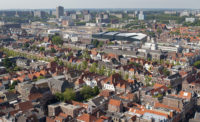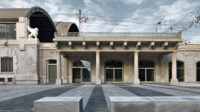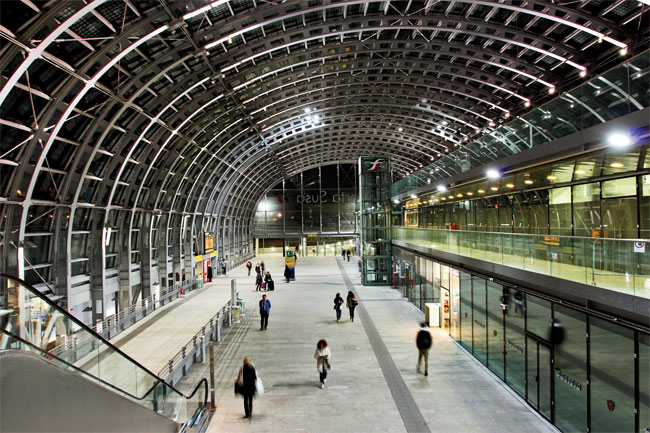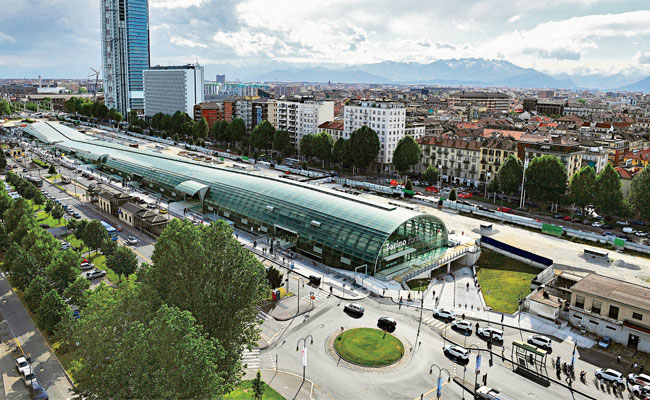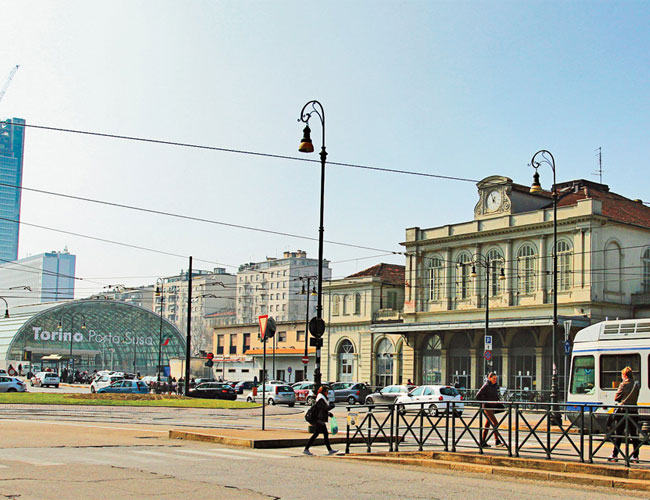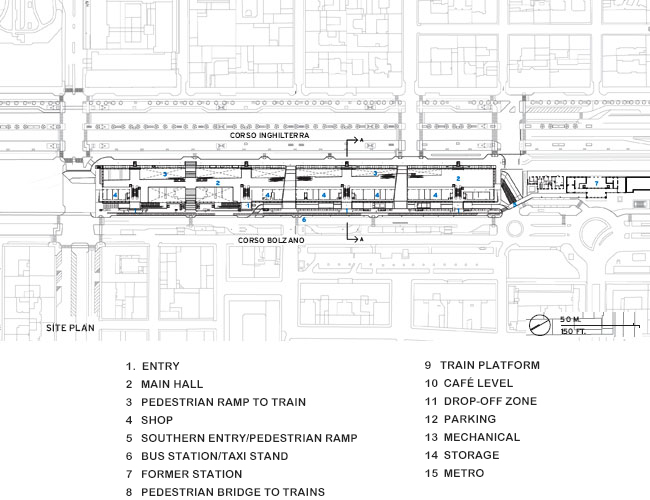Turin, Italy
Paris-based Italian architect Silvio d'Ascia conceived Turin's Porta Susa High-Speed Train Station as a new urban crossroads. In so doing, he hoped to help suture the long-standing rift that the railroad had created between the city's disparate halves. The building's glazed, vaulted main concourse also evokes both the traditional iron-and-glass sheds of railroad terminals and the glass-roofed commercial galleries of northern Italian cities (most notably, Milan's Galleria Vittorio Emanuele II, although Turin boasts a couple of its own). D'Ascia hoped to emulate such spaces—which were a key reference for the Italian Tendenza movement, when he was a student in Naples in the 1980s—while remaining thoroughly contemporary, he says, but “without any trace of postmodernism.”
The tube-like station, which sits above the now-buried tracks, stretches more than 1,200 feet, the same length as the high-speed trains that stop here on their way to Paris and Rome. The station also serves regional and commuter rail lines and has a metro stop, as well as underground parking. Its main concourse is one level below grade and is spanned at regular intervals by street-level bridges, which, like the larger urban plan, help connect the two sides of the city. D'Ascia has designed the new building—which replaces a smaller existing station that awaits future uses—as a magnificent promenade, soon to be filled with stores, restaurants, and cafés. He also envisions other activities for the space, such as markets, fairs, and music performances, creating a focal point where previously surface-level tracks formed a barrier across the city.
Approached from the street, Porta Susa is monumental in scale but low to the ground, communicating its role as a mediator between the city and the subterranean platforms. D'Ascia has manipulated the building's vault along its course, gradually flattening and lowering its arch toward the south, and then bringing it back up again to full height at its southern terminus, where it will connect to his future tower. “The idea was to follow the flow of the interior,” he explains. “The lowest part of the gallery corresponds to the void of the metro station, 70 feet below grade.” On one side of the interior, mezzanines and terraces for restaurants and shopping overlook the concourse. On the opposite side, a long ramp descends from the main concourse to the depths of the metro station.
The building's materials and detailing could be described as no-frills high-tech, in keeping with the tight budget of $90 million for over 323,000 square feet of space. The floors are of local granite, and the structure is a series of steel ribs with perforated webbing, digitally designed and fabricated to adapt to the vault's flowing shape. Grids of photovoltaic cells cover the glass and will produce 680,000 kilowatt-hours per year. The hall is ventilated via louvers between the glass panels, which are staggered like shingles to accommodate the curving profile. Fans draw cool air from the train tunnels, and a misting system produces a cooling effect on hot days.
Not all the elements of the project are smoothly resolved, however. The variety of different-shaped and -sized entries, combined with an assortment of stairs and ramps, create a visual discord along the length of the station. Additionally, exteriors are cluttered with ventilation stacks and other mechanical equipment, often less than elegantly enclosed in louvered sheds. The train platforms—which were not designed by D'Ascia but by technicians of the RFI, the state-controlled railroad—are grim, functional spaces, especially the access-ways. But the roughness of some of these elements is not out of step with the character of classic railroad stations. “This is not an airport,” the architect points out. It's not a sealed, climate-controlled environment but a shed, open to the weather and to the sound of arriving trains.
The exaggerated length of the building—it is far longer than functionally necessary—echoes other features of central Turin: its boulevards with monumental arcades and its leafy avenues lined with mature trees. Its great length also recalls one of the city's most famous landmarks, the 1923 Fiat Factory at Lingotto, more than 1,600 feet long, with a test track on its roof. In 1989, Renzo Piano converted the building into a multiuse commercial and cultural center, creating an urban amenity for the city's working-class district and Turin as a whole. As the Porta Susa concourse fills out with activity, this role as a thronging pedestrian thoroughfare is one it can aspire to as well.
PeopleClient: RFI Ferservizi (Groupe FS) Owner: RFI Ferservizi (Groupe FS)
Architect:
Personnel in architect's firm who should receive special credit:
Associate architect(s):
Engineers:
Consultant(s): Other: G. Aragona (economist) General contractor: Cogel SPA, Pivato SPA, CESI Soc. Coop
Photographer(s):
Giovanni Fontana Size: 323,000 square feet Construction cost: $88 million Completion date: January 2013 |
Products
Structural system Manufacturer of any structural components unique to this project: BIT SPA
Exterior cladding Metal/glass curtain wall: Cima Srl (facades, interior finishes, glass panels) Rainscreen (terra cotta, composite, etc.): Cima Srl Precast concrete: Cogel SPA, Pivato SPA, CESI Soc. Coop Moisture barrier: Cima Srl Other cladding unique to this project: integrated photovoltaic system by EnergyGlass
Windows
Glazing Skylights: Cima Srl, EnergyGlass
Doors Metal doors: Cima Srl Sliding doors: Cima Srl Fire-control doors, security grilles: Cima Srl Upswinging doors, other: Cima Srl
Hardware Closers: Cima Srl
Exit devices: Cima Srl / Happy Vision Security devices: Cima Srl / Happy Vision
Interior finishes Suspension grid: CESI Paneling: CIMA (microperforated panels) Solid surfacing: CESI (concrete flooring) Special surfacing: Cave San Basilio (Luserna paving stone, Turin’s vernacular stone) Resilient flooring: CESI
Lighting Downlights: Disano / Diesse Electra Exterior: Disano / Diesse Electra Dimming System or other lighting controls: Disano / Diesse Electra
Conveyance Accessibility provision: Schindler
Energy
Add any additional building components or special equipment that made a significant contribution to this project: |













